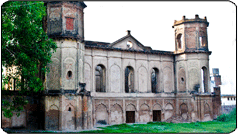AalamBagh
The name Alumbagh or Aalam Bagh implies a garden complex, but one desirous of finding a Bagh (garden) in the area known today as Aalam Bagh will only find a horticulture department's garden between Adarsh nagar and Barha colony on the other side of the Char Bagh Railway station [quite a distance away from the original site of Aalam Bagh garden palace].
Also, if one goes in search of Aalam Bagh gateway that is extant, by the location of Aalam bagh police station, he will be misled because the gateway is more than a kilometre away from the police station. The place where the gateway of Aalam Bagh exists is today known as Chander nagar [for a colony] inhabited by refugees' families that had settled here after Independence. Some people erroneously call the Aalam Bagh gateway as the Chander nagar gateway.
Aalam Bagh was originally a sylvan glade and some apartments appear to have been in existence there even before the double storeyed palace for Aalam Aara Begum was built by Nawab Wajid Ali Shah. There is an account which says that Afzal Begum, the mother of Fareidon Bakht alias Munna Jaan, the son of Naseer-ud-Din Haider stayed at Aalam Bagh.
The last King of Awadh, Wajid Ali Shah, was married to Aalam Aara Begum at the age of fifteen in 1837 when the second King Naseer-ud-Din Haider (1827-1837) was the ruler (at that time Wajid Ali was'nt even in the direct line of succession to the throne). The new bride, the daughter of Nawab Ali Khan was given the title of Aazam Bahu Begum. She was later known as Khaas Mahal (the chief Queen) when Wajid Ali was installed as the Shah (king) of Awadh in 1847.
Both Wajid Ali and Aalam Aara Begum had a common interest in prosody and composed couplets (sheyr) with a takhallus (poet's pen name) of Akhtar and Aalam respectively. But despite their common interest in poetry and that she was given the highest honour of the King's household with the title Malka-e-Maqdara-e-Azma, Badshah Begum, their relations soured when Wajid Ali Shah began having extra-marital affairs and directed his attention towards other women (whom he married and housed in his seraglio).
Inspite of her strained relations with Wajid Ali Shah, acting as a dutifui wife, Aalam Aara went with him to Matia Burj at Calcutta, where the British interned the deposed King after the iiiegimate annexation of Awadh in February 1856. [Some of his wives avoided and refused being with him during his exile]. Ironically, the British confiscated Aalam Bagh in her absence and refused her claim of compensation for the property. She expired at Matia Burj on March 31,1894, seven years after the death of her husband on September 21, 1887.
An idea of Aalam Bagh, as it was, may be visualised from a hurried description given in the journal of Arthur Moffat Lang who was at Lucknow with the British troops in November 1857. His entry of 6th November states The party who came back from Alambagh last night describe it as a large enclosure 500 yards by 470 yards rectangular with a two storeyed gilded domed tower at each of the four corners; a large Baradari in the centre, a gateway in the centre of each side, the principal one towards the road having a building on each side of the entrance. A wall 11 feet high 21/2 feet thick enclosed it'.
The description was probably meant as an information for military preparation before an attack and lacks the details of beautification, except for the gilded domes on the tower which have vanished since then.
An illustration in Glimpse of the Burning Plain by Charles Allen that gives the account of Charlotte Canning, the sister of Governor General, Lord Canning, who travelled in India from 1859 to 1861 and was at Lucknow in October 1859 gives a sketch probably made by her (she has sketched and painted many scenes of her visit) in which the main palace, the gateway and a watch tower in the foreground are shown along with a number of elephants and camels with men [near an embankment and trench created for defence]. All the three constructions are double storeyed but the main palace though in the back, appears quite high and majestic. It is a European style building with tall Corinthian columns on the ground and first floor supporting a triangular pediment on the top. The four towers at the corners, are bereft of the gilded domes cited by Lang. On the left hand of the picture at a distance, further away from the gateway, appears a mosque with three domes and two minarets. The mosque is still extant [as Shahi Masjid] on the other side of the Kanpur road opposite the Aalam Bagh gateway.
Aalam Bagh was initially a stronghold of freedom fighters during the struggle against the British in 1857, but the British forces that arrived from Kanpur via Unnao and initially camped at Fort Jalalabad (now erroneously named Bijli Pasi ka Qila) captured Aalam Bagh on September 23, 1857. Thereafter, besides being a camp for the troops it also served as a field hospital during the struggle when it was left under General Outram with 4000 men and 32 pieces of artillery for defence against the attack of rebel forces.
Maulvi Ahmad-ullah Shah made a cavalry attack on Aaiam Bagh on Febuary 15,1858 which was followed by an attack ten days later, led by Begum Hazrat Mahal mounted on an elephant. Despite fierce fighting on both these occasions, it was not possible to penetrate into the elaborate defence of mud embankments and trenches created by the British and Aalam Bagh continued to remain as a stronghold of the British.
A semaphore (visual telegraph system) set atop the Aalam Bagh palace kept in contact with the one set atop Dilkusha palace which was then the headquarters of the British Commander-in-Chief, Colin Campbell. This exchange of communication proved of great help to the British in their recapture of Lucknow, finally on March 16, 1858.
Within Aalam Bagh, there is also a memorial for Major General Havelock (built over his grave) who died of dysentry on November 24, 1857 [at Dilkusha Kothi]. The land around the memorial had been grabbed by some colonisers. With the efforts of a society in England that looks after the upkeep of British cemeteries in India and the intervention of British High Commission, the land was restored to the care of Archaeological Survey of India, which has fenced the place and has provided a guard at the entrance of the protected monument.
However, the palace of Aalam Aara and the gateway of Aalam Bagh which are under the UP. State Archaeology Department' are badly maintained and encroachments abound these protected sites in the form of shops and stalls of vegetable market.
Source:
Hindustan Times, City Scan, A Time in History
Wednesday 28.1.1998 — That sylvan glade exists no more - Aalam Bagh

